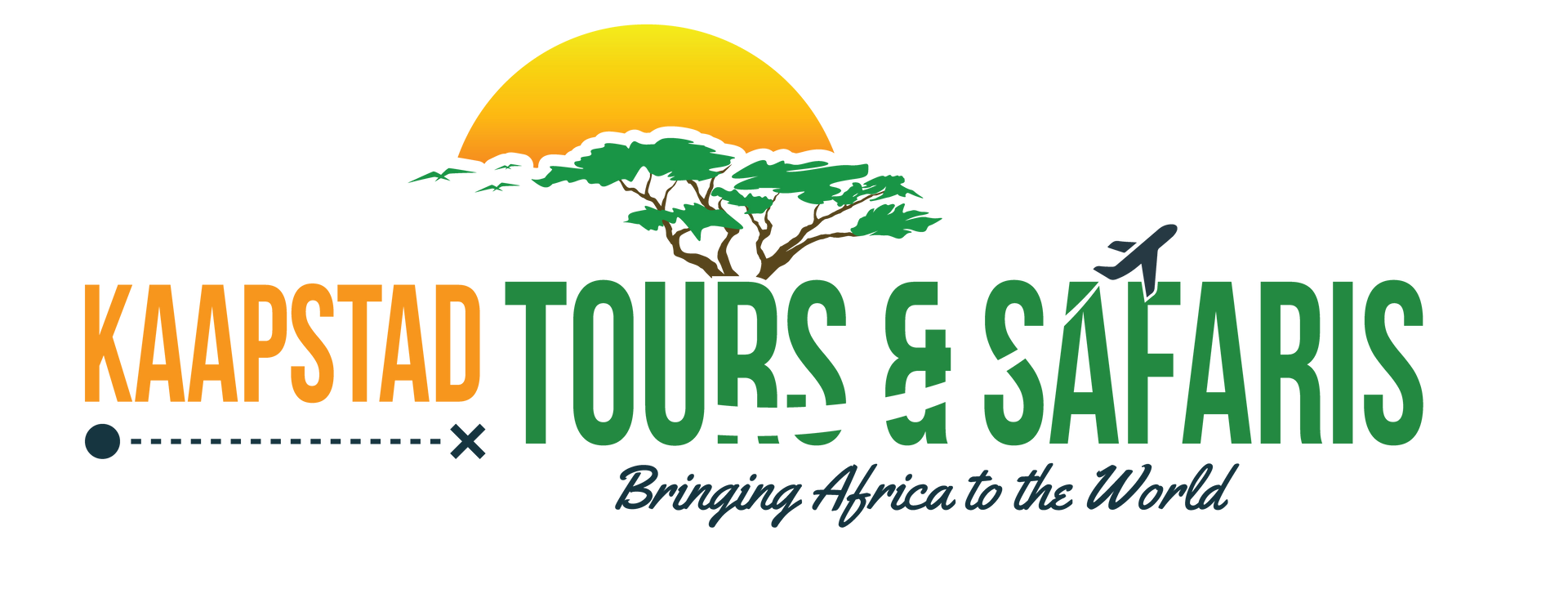SAFARIS
INTO THE WILDERNESS
South Africa is an eco-tourism paradise with an enormous fauna and flora diversity. The Big-5: lion, buffalo, elephant, rhino and leopard survive in most of the national parks. There are 20 National Parks and more than 500 smaller regional reserves. While the one reserve has been established to protect a certain animal, the other is established to protect fauna or a landscape. The most famous reserve is the Kruger National Park in the northeast, a 20.000 km² reserve where the Big 5 can live undisturbed. It is one of South Africa’s major tourist destinations.
Most national parks offers accommodation in different price ranges and comfort classes. Visitors can travel on their own through the national parks or make use of organised tours. Reserves in northern KwaZulu-Natal are known for the large diversity in fauna and flora while in the northwest a gigantic reserve is established in collaboration with Namibia and Botswana: the Kgalagadi Transnational Park (the previous Kalahari Gemsbok National Park and the Gemsbok National Park in Botswana). This giant reserve has a surface of 38.000 km², endless Kalahari semi dessert, rocks, dunes, driver river banks and thorn bush.
The Eastern Cape and Northwest Province are malaria free as well as the Western Cape and Northern Cape provinces. Thought there is a risk of malaria, the risk is small but if it is a concern to you, a Big-5 safari in the mentioned provinces is perfectly possible.
HWANGE NATIONAL PARK - ZIMBABWE
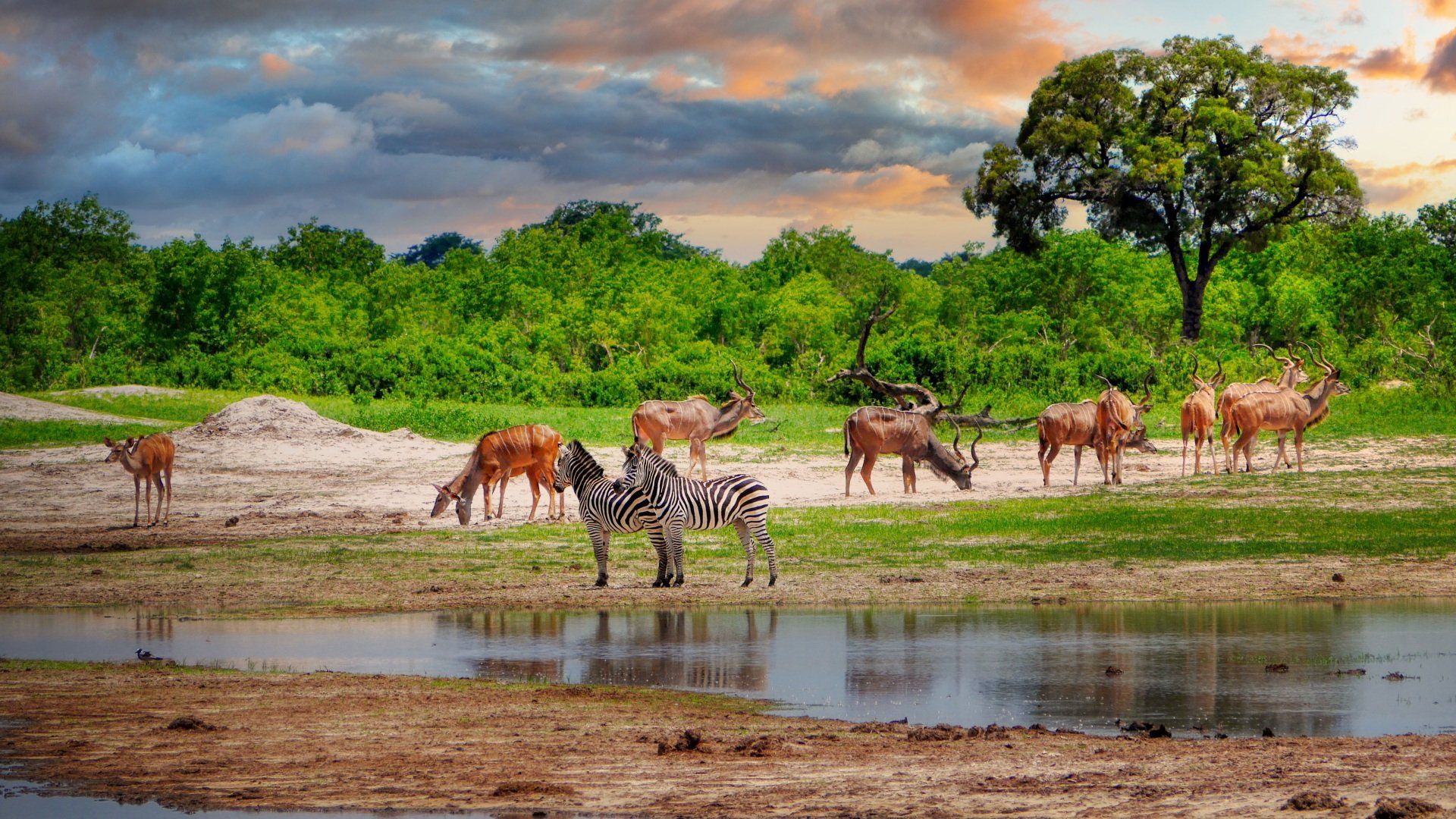
Slide title
Write your caption hereButton
Hwange National Park, the largest park in Zimbabwe, is a national gem and worthy of protection. With over 108 animal species and over 470 species of birds, including 50 raptors, Hwange has one of the highest diversities of wildlife of any national park in the world. But it was not always the wildlife paradise it is today, it was declared a game reserve in 1928 when wildlife numbers were diminished, and along with neighbouring Robins Game sanctuary, it became a national park under the National Park Act of 1949. The first warden of the park, a young Ted Davison, realised early on that water is critical to providing an area where animals would frequent and remain within its borders. He implemented boreholes throughout the park, creating an estimated 60 new pans in addition to the natural seasonal pans and groundwater seeps. Over the years, wildlife including large herds of elephant and buffalo, began to move back to the area, attracted to the reliable sources of water. It has become evident that the consistent maintenance of these artificial waterholes has been a major contributing factor in sustaining this ecological treasure.
HWANGE NATIONAL PARK - ZIMBABWE

Slide title
Write your caption hereButton
Hwange National Park, the largest park in Zimbabwe, is a national gem and worthy of protection. With over 108 animal species and over 470 species of birds, including 50 raptors, Hwange has one of the highest diversities of wildlife of any national park in the world. But it was not always the wildlife paradise it is today, it was declared a game reserve in 1928 when wildlife numbers were diminished, and along with neighbouring Robins Game sanctuary, it became a national park under the National Park Act of 1949. The first warden of the park, a young Ted Davison, realised early on that water is critical to providing an area where animals would frequent and remain within its borders. He implemented boreholes throughout the park, creating an estimated 60 new pans in addition to the natural seasonal pans and groundwater seeps. Over the years, wildlife including large herds of elephant and buffalo, began to move back to the area, attracted to the reliable sources of water. It has become evident that the consistent maintenance of these artificial waterholes has been a major contributing factor in sustaining this ecological treasure.
ETOSHA NATIONAL PARK - NAMIBIA
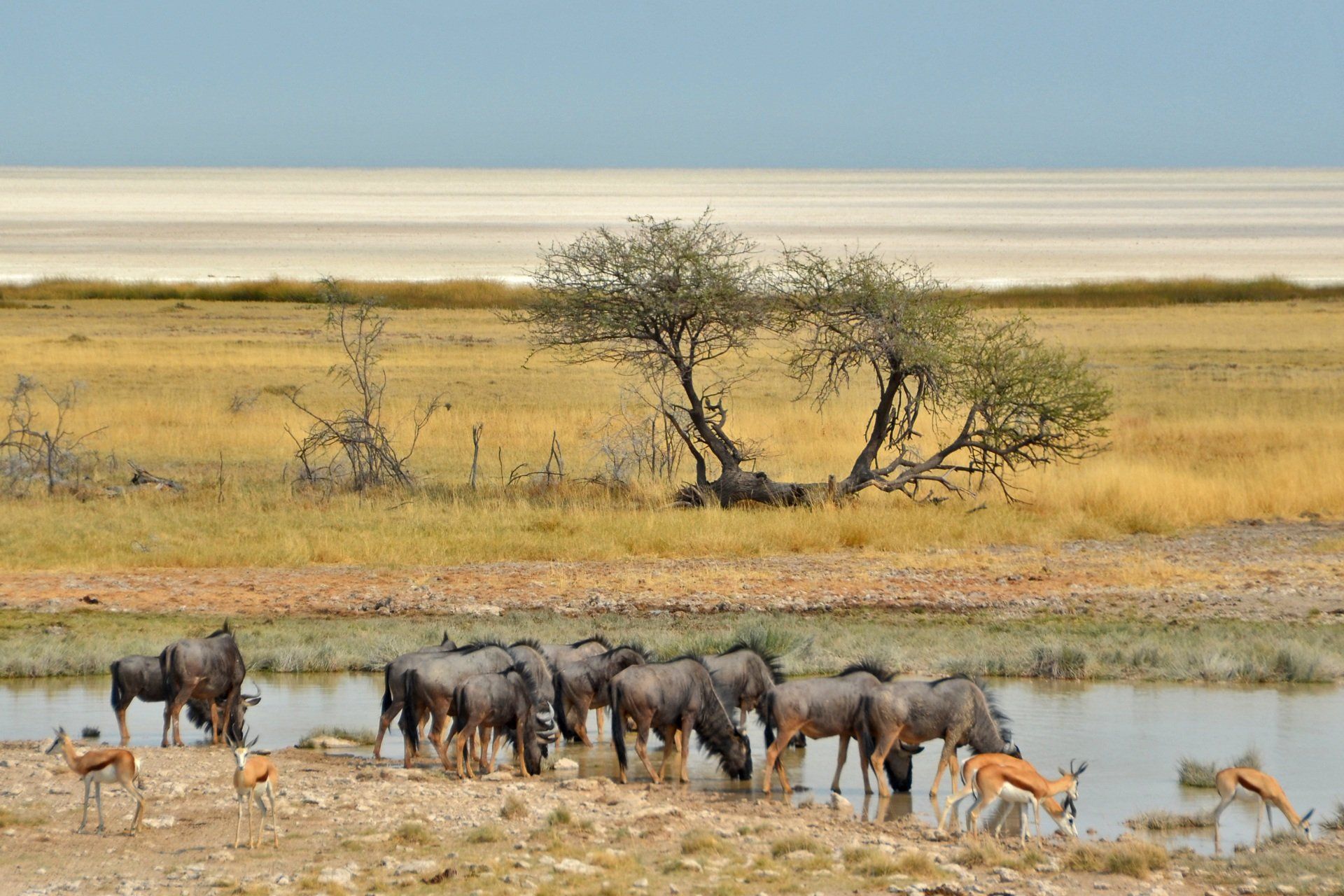
Slide title
Write your caption hereButton
The Etosha National Park is one of the Africa’s great game parks. Centred around the vast expanse of the Etosha Pan, the park is a sanctuary to the largest population of the western subspecies of the black rhino, white rhino, large herds of elephant, the striking black-faced impala, lions and a profusion of other animals and birds. To the northwest of Etosha lies the arid, but scenic Kaokoveld, a mosaic of sandy plains, rugged mountains and rock-strewn hillsides, bounded in the north by the Kunene River. Kaokoland has been the ancestral home of the pastoral Himba for several generations and they still largely pursue their nomadic way of life. Herds of desert elephants migrate along river valleys that are also inhabited by giraffe, while herds of gemsbok and springbok roam the plains.
ETAOSHA NATIONAL PARK - NAMIBIA

Slide title
Write your caption hereButton
The Etosha National Park is one of the Africa’s great game parks. Centred around the vast expanse of the Etosha Pan, the park is a sanctuary to the largest population of the western subspecies of the black rhino, white rhino, large herds of elephant, the striking black-faced impala, lions and a profusion of other animals and birds. To the northwest of Etosha lies the arid, but scenic Kaokoveld, a mosaic of sandy plains, rugged mountains and rock-strewn hillsides, bounded in the north by the Kunene River. Kaokoland has been the ancestral home of the pastoral Himba for several generations and they still largely pursue their nomadic way of life. Herds of desert elephants migrate along river valleys that are also inhabited by giraffe, while herds of gemsbok and springbok roam the plains.
CHOBE NATIONAL PARK - BOTSWANA
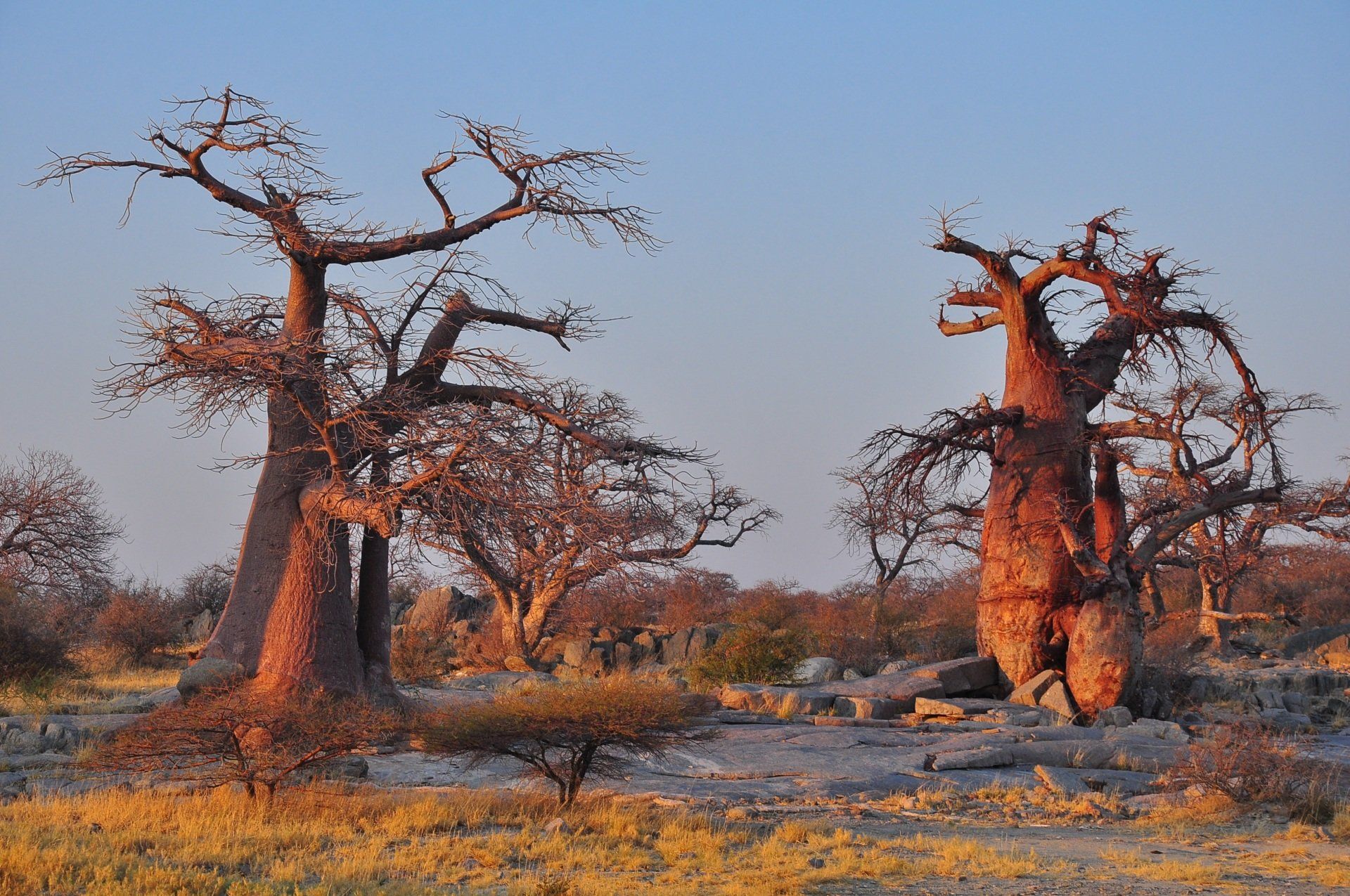
Slide title
Write your caption hereButton
Situated in northwest Botswana, has one of the largest game concentration in Africa continent. By size, this is the third largest park of the country, after the Central Kalahari Game Reserve and the Gemsbok National Park, and is the most diverse. This is also the country’s first national park.
The park can be divided up to 4 areas, each corresponding to one distinct ecosystem:
- The Serondela area (or Chobe riverfront), situated in the extreme Northeast of the park, has as main geographical features lush plains and dense teak forests.
- The Savuti Marsh area, 10 878 km² large, constitutes the western stretch of the park (50 km north of Mababe Gate). The Savuti Marsh is the relic of a large inland lake whose water supply was cut a long time ago by tectonic movements.
- The Linyanti Marsh, located at the Northwest corner of the park and to the North of Savuti, is adjacent to Linyanti River. To the west of this area lies Selinda Reserve and on the Northern bank of Kwando River is Namibia’s Mamili National Park.
CHOBE NATIONAL PARK - BOTSWANA

Slide title
Write your caption hereButton
Situated in northwest Botswana, has one of the largest game concentration in Africa continent. By size, this is the third largest park of the country, after the Central Kalahari Game Reserve and the Gemsbok National Park, and is the most diverse. This is also the country’s first national park.
The park can be divided up to 4 areas, each corresponding to one distinct ecosystem:
- The Serondela area (or Chobe riverfront), situated in the extreme Northeast of the park, has as main geographical features lush plains and dense teak forests.
- The Savuti Marsh area, 10 878 km² large, constitutes the western stretch of the park (50 km north of Mababe Gate). The Savuti Marsh is the relic of a large inland lake whose water supply was cut a long time ago by tectonic movements.
- The Linyanti Marsh, located at the Northwest corner of the park and to the North of Savuti, is adjacent to Linyanti River. To the west of this area lies Selinda Reserve and on the Northern bank of Kwando River is Namibia’s Mamili National Park.
OKAVANGO DELTA - BOTSWANA
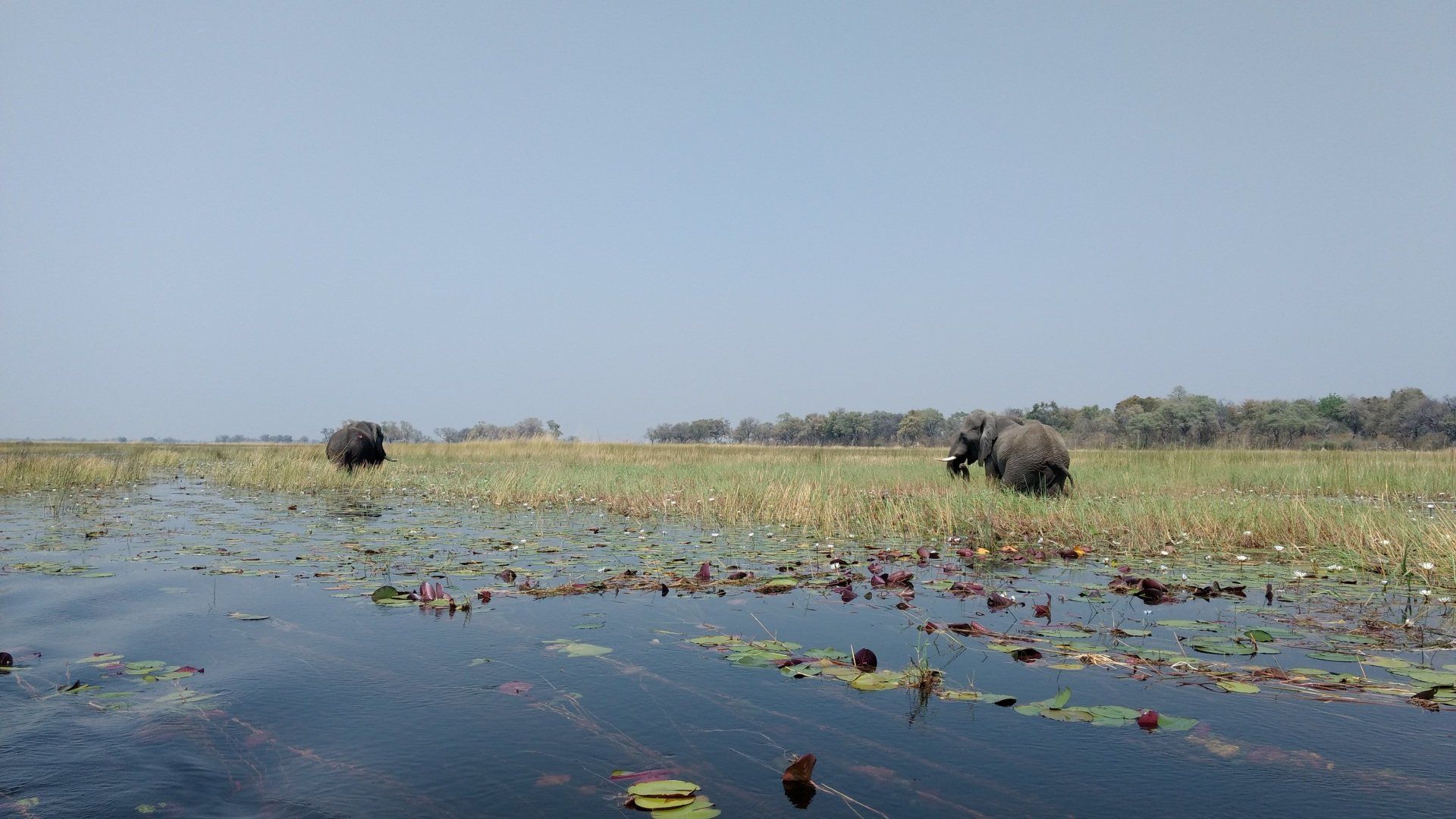
Slide title
Write your caption hereButton
The Okavango Delta is home to a great amount of wildlife, attracting visitors that want to experience a true African wilderness safari. The meandering Okavango River is best seen best by boat trip or by taking a scenic flight. Safaris in Okavango Delta area take you to a multitude of destinations from the popular Moremi Game Reserve in the western part of the Okavango Delta to the Makgadikgadi Reserve, Nxai Pan and Aha Hills, all great for wildlife viewing in Okavango area. The World Heritage Site of Tsodilo Hills offers some 4500 ancient rock paintings done by the Bushmen, and their ancient lifestyle can be experienced for example in Khwai village close to Moremi. The main town in Okavango, Maun is the gateway to the Delta, and has its share of lodges, safari shops and tour operator offices. Scenic flights in Okavango Delta start from Maun airport. There is also an educational safari park in Maun. Nhabe Museum in the northeast of Okavango Delta has exhibitions about the natural history and culture of the region.
OKAVANGO DELTA - BOTSWANA

Slide title
Write your caption hereButton
The Okavango Delta is home to a great amount of wildlife, attracting visitors that want to experience a true African wilderness safari. The meandering Okavango River is best seen best by boat trip or by taking a scenic flight. Safaris in Okavango Delta area take you to a multitude of destinations from the popular Moremi Game Reserve in the western part of the Okavango Delta to the Makgadikgadi Reserve, Nxai Pan and Aha Hills, all great for wildlife viewing in Okavango area. The World Heritage Site of Tsodilo Hills offers some 4500 ancient rock paintings done by the Bushmen, and their ancient lifestyle can be experienced for example in Khwai village close to Moremi. The main town in Okavango, Maun is the gateway to the Delta, and has its share of lodges, safari shops and tour operator offices. Scenic flights in Okavango Delta start from Maun airport. There is also an educational safari park in Maun. Nhabe Museum in the northeast of Okavango Delta has exhibitions about the natural history and culture of the region.
CENTRAL KALAHARI GAME RESERVE - BOTSWANA
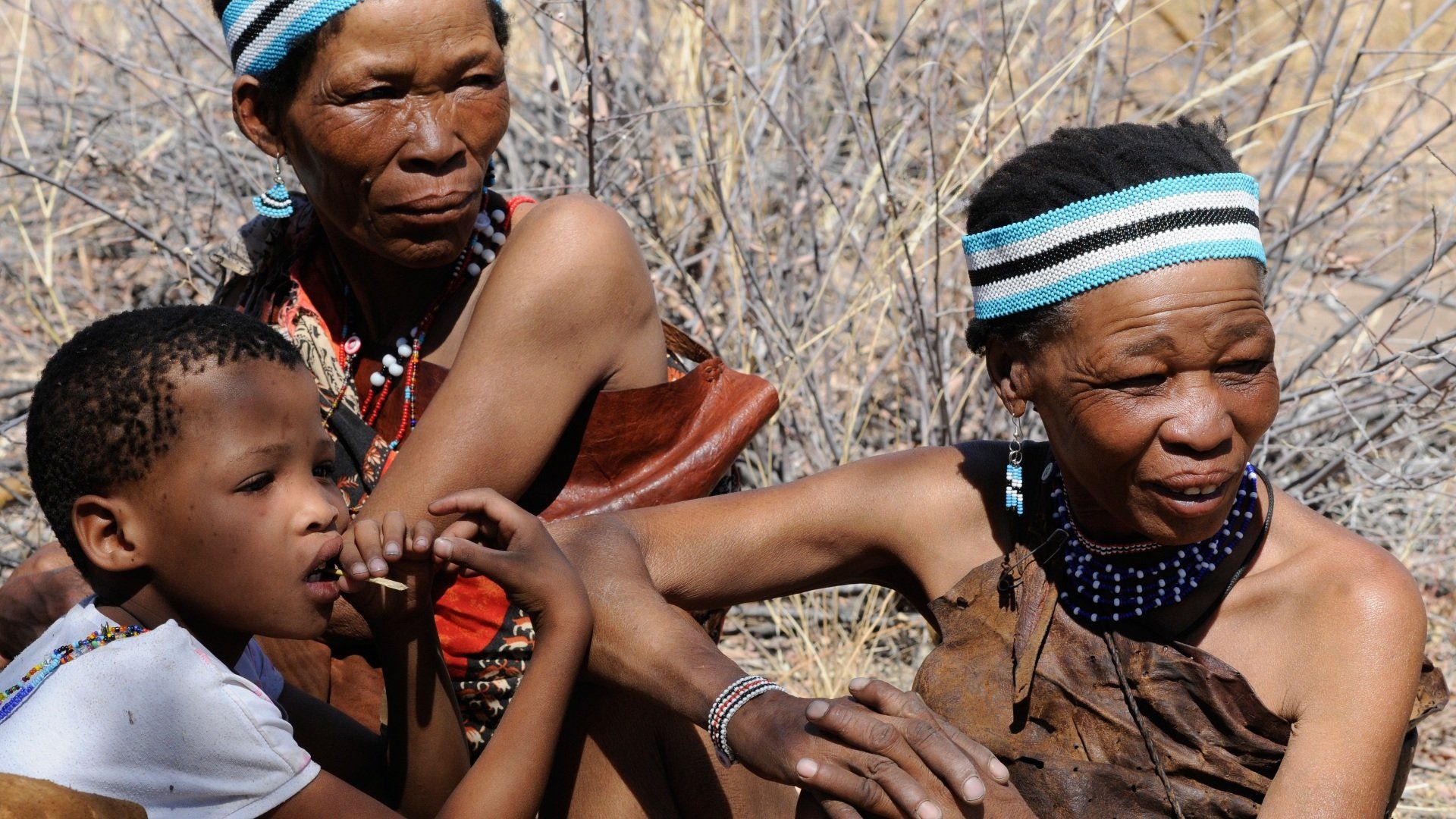
Slide title
Write your caption hereButton
Central Kalahari Game Reserve is an extensive national park in the Kalahari Desert of Botswana. Established in 1961 it covers an area of 52,800 km² making it the second largest game reserve in the world. About 40.000 years ago, Today’s Kalahari Desert was once the bed of a giant inland lake that would have been up to 300 meter deep in places. Tectonic shifts caused this lake to drift off and dry out, leaving behind a paradoxically parched environment where dry sand can lie as much as half a kilometer deep. The park contains wildlife such as giraffe, brown hyena, warthog, cheetah, wild dog, leopard, lion, blue wildebeest, eland, gemsbok, kudu and red hartebeest. The land is mostly flat, and gently undulating covered with bush and grasses covering the sand dunes, and areas of larger trees. Many of the river valleys are fossilized with salt pans. Four fossilized rivers meander through the reserve including Deception Valley which began to form around 16,000 years ago The Bushmen, or San, have inhabited the lands for thousands of years since they roamed the area as nomadic hunters. However, since the mid-1990s the Botswanan government has tried to relocate the Bushmen from the reserve claiming it is a drain on financial resources despite revenues increasing by tourism to the reserve. In 1997, three quarters of the entire San population were relocated from the reserve, and in October 2005 the government had resumed the forced relocation into resettlement camps outside of the park leaving only about 250 permanent occupiers. But in 2006 a Botswanan court proclaimed the eviction illegal by allowing people to return in Central Kalahari Game Reserve. A huge bush fire destroyed large parts of the reserve by mid of September 2008. The origin of the fire remains unknown.
CENTRAL KALAHARI GAME RESERVE - BOTSWANA

Slide title
Write your caption hereButton
Central Kalahari Game Reserve is an extensive national park in the Kalahari Desert of Botswana. Established in 1961 it covers an area of 52,800 km² making it the second largest game reserve in the world. About 40.000 years ago, Today’s Kalahari Desert was once the bed of a giant inland lake that would have been up to 300 meter deep in places. Tectonic shifts caused this lake to drift off and dry out, leaving behind a paradoxically parched environment where dry sand can lie as much as half a kilometer deep. The park contains wildlife such as giraffe, brown hyena, warthog, cheetah, wild dog, leopard, lion, blue wildebeest, eland, gemsbok, kudu and red hartebeest. The land is mostly flat, and gently undulating covered with bush and grasses covering the sand dunes, and areas of larger trees. Many of the river valleys are fossilized with salt pans. Four fossilized rivers meander through the reserve including Deception Valley which began to form around 16,000 years ago The Bushmen, or San, have inhabited the lands for thousands of years since they roamed the area as nomadic hunters. However, since the mid-1990s the Botswanan government has tried to relocate the Bushmen from the reserve claiming it is a drain on financial resources despite revenues increasing by tourism to the reserve. In 1997, three quarters of the entire San population were relocated from the reserve, and in October 2005 the government had resumed the forced relocation into resettlement camps outside of the park leaving only about 250 permanent occupiers. But in 2006 a Botswanan court proclaimed the eviction illegal by allowing people to return in Central Kalahari Game Reserve. A huge bush fire destroyed large parts of the reserve by mid of September 2008. The origin of the fire remains unknown.
GET IN TOUCH
Email:
Phone: +27 82 297 5218
Address:
23 Gemsbok Street
Krugersdorp
South Africa,
1731
Contact Us
We will get back to you as soon as possible.
Please try again later.
